AGE.
211

1-Year-Old, Lower Jaw (Brandt).
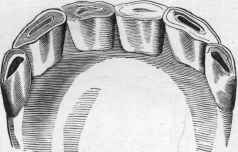
2-Year-Old, Lower Jaw; drawn from Nature.

8-Year-Old. Lower Jaw; drawn from Nature.
4
212 AGE.

4-Year-Old, Lower Jaw; drawn from Nature.
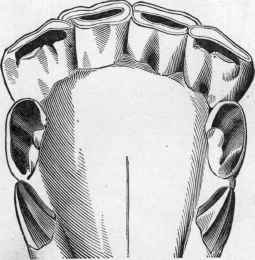
5-Year-Old, Lower Jaw; drawn from Nature.
AGE.
213

6-Year-Old, Lower Jaw ; drawn from Nature.
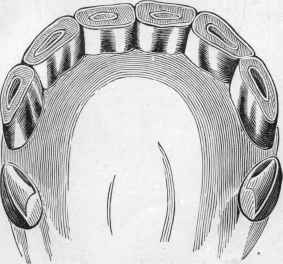
7YearOld, Lower Jaw (Brandt),
AGE.

8-Year-Old, Upper Jaw (Walsh). About 2/3 nat. size.

9-Year-Old, Upper Jaw (Walsh). About 2/3 nat. size.
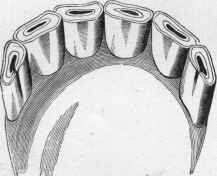
10-Year-Old, Upper Jaw (Walsh). About 2/3 nat. size.
214
AGE.
215

11 years, Upper Jaw. The marks have disappeared.
The Mark, dissected as it
were. (See page 221.)

c, The Dentinal star, some
times mistaken for the
mark. (See page 221.)

12 years, Lower Jaw. Change in shape is now clearly defined.
The respective pairs (centrals, dividers, corners) assume in turn
(from 12 years till old age) various shapes—semi-square, rounded,
triangular, wedge-shaped, etc.
216 AGE.
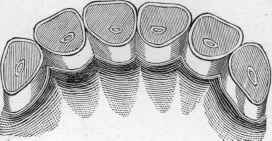
13 years, Lower Jaw.
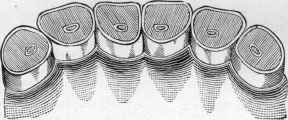
14 years, Lower Jaw.
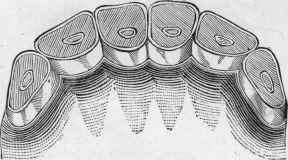
15 years, Upper Jaw.
AGE.
217

16 years, Upper Jaw.

17 years, Upper Jaw.

18 years, Lower Jaw.

19 years, Lower Jaw.
218
AGE.

20 years, Lower Jaw.

21 years, Upper Jaw.

22 years, Upper Jaw.
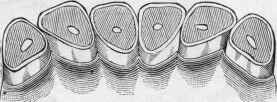
23 years, Upper Jaw.
AGE. 219

24 years, Lower Jaw.

25 years, Lower Jaw.

26 years, Lower Jaw.

27 years, Upper Jaw.
220
AGE.

28 years, Upper Jaw.

29 years, Upper Jaw.

A Parrot-Mouth (lower jaw). The ten lines represent ten
years’ growth. The marks, having never been worn, represent
a 6-year-old. The horse is therefore 16 years old. (This cut,
as well as many of the preceding, is from Braudt’s “Age of
Horses.”)
THE MARK AND DENTINAL STAR.
(Illustrated on page 215.)
The mark (also called central enamel, infundibulum,
&c) is composed of enamel, the hardest of the three con
stituent parts of the teeth—enamel, dentine, and cement.
The dentinal star, so called because it is composed of
dentine, appears about the. ninth year. It has a yellow
tint, which is the best means of distinguishing it from
the mark. Its appearance is accounted for as follows :
When the tooth wears nearly to the pulp or nerve cavity,
the pulp becomes gradually converted into dentine, fill
ing the upper part of the cavity from the inside as per
fectly as a dentist can fill a cavity from the outside. The
star is visible eight or ten years. After it is worn out,
there will be a cavity of course.
But first, if you want to come back to this web site again, just add it to your bookmarks or favorites now! Then you'll find it easy!
Also, please consider sharing our helpful website with your online friends.
BELOW ARE OUR OTHER HEALTH WEB SITES: |
Copyright © 2000-present Donald Urquhart. All Rights Reserved. All universal rights reserved. Designated trademarks and brands are the property of their respective owners. Use of this Web site constitutes acceptance of our legal disclaimer. | Contact Us | Privacy Policy | About Us |